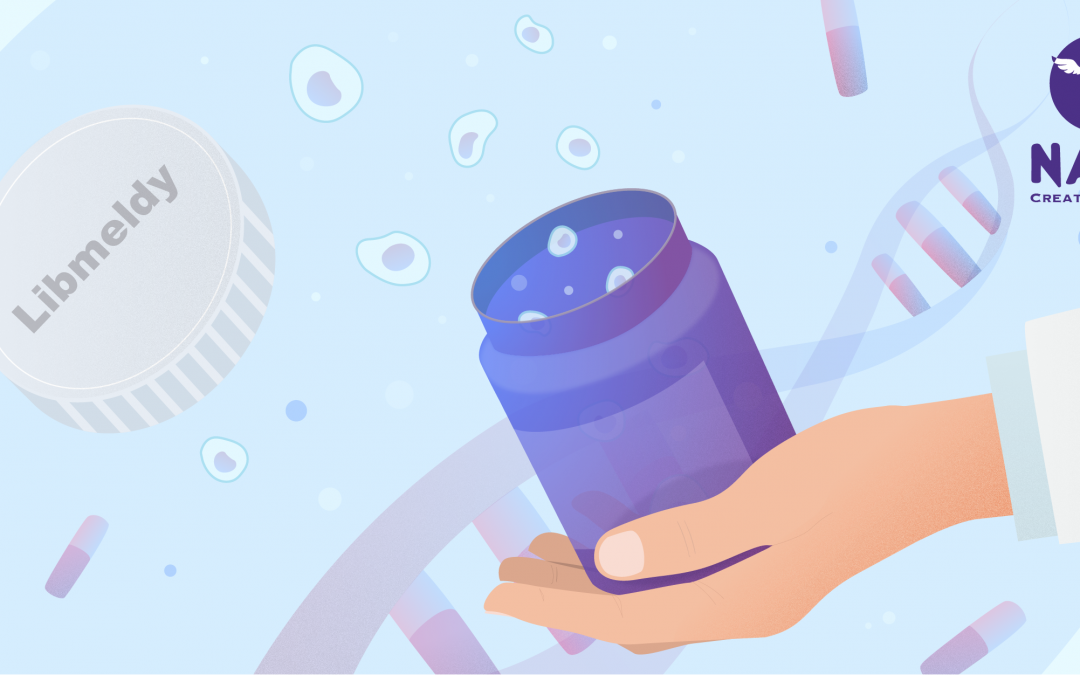“Carefully read the package leaflet”.
Born in Haifa from the love of two architects, the Leonardo fa Vinci of Today spent her infancy “between nature and culture”, that is between her grandmother’s garden and her parent’s architectural studio. But what if this time there was something alive in the package?
One month after the approval by the European Medicines Agency (EMA), we start today our blog talking about Libmeldy, the first drug based on genetically corrected cells for the treatment of metachromatic leukodystrophy.
INDEX:
- The difference between “treatment” and “cure”;
- Transferring genes through viral vectors;
- Libmeldy: a gene therapy for metachromatic leukodystrophy.
Metachromatic leukodystrophy (MLD) is a rare genetic metabolic disease that affects different apparatus including the central and peripheral nervous systems.
The cause lies in the mutation of the ARSA gene encoding for the arylsulfatase A enzyme. The absence of this enzyme causes the toxic accumulation of sulfatides (chemical compounds highly present in the cell membrane) with consequent loss of motor and cognitive functions until death in early-onset cases, which are the most common as well as the most severe.
1. THE DIFFERENCE BETWEEN “TREATMENT” AND “CURE”
In medicine, there are mainly two ways to approach diseases:
• “Treatment” – reducing symptoms without deleting the primary cause;
• “Cure” – resolving the problem definitively by deleting its origin.
The complexity of genetic diseases has often led medicine to approach them with treatments, rather than with real cures.
This is because the cause of a genetic disease lies in the genome, which until a few years ago was technologically impossible to modify.
The genome is the long instruction manual that cells read to produce the proteins necessary to carry out their functions. Genetic mutations are errors within this manual that prevent the cells from reading a specific page.
One possible approach to cure a genetic disease is to replace the patient’s mutated cells with cells from a healthy donor: the so-called transplantation. This solution, although effective in various clinical scenarios, also presents multiple limitations:
- Organ transplantation is applicable only to a small fraction of genetic diseases;
- To avoid the rejection of the new organ by the patient’s immune system, it is often necessary to administer immunosuppressive drugs, which however significantly lower the patient’s quality of life;
- The availability of organs for transplants is limiting and therefore does not allow a large-scale application of this solution.
Instead, the ideal way to cure a genetic disease would be to provide the patient’s cells with a corrected copy of the mutated gene.
But how to deliver a new gene to a cell?
2. TRANSFERRING GENES THROUGH VIRAL VECTORS
Humans have always looked for inspiration in Nature to find efficient solutions to complex problems and this case is no exception: to transfer genes inside cells researchers found their inspiration in viruses.
In fact, viruses have evolved over the millennia to be extremely efficient in transferring their genetic material to the cells they infect. This is because viruses belong to the so-called obligate parasites, unable to reproduce and survive outside the host, being nothing more than an envelope containing the instructions for generating other viruses. In order to propagate, they need to infect a cell that, through its proteins, can read these instructions and thus produce other viruses.
Thanks to this ability, viruses represent a potential tool to efficiently transfer the missing genetic information to the patient’s cells.
In order to do this, however, it is necessary to identify a virus suitable for infecting the cells that have to be corrected and to engineer it in the laboratory as follows:
- Deprive the virus of its genetic material, so that it no longer contains the instructions that would allow the virus to propagate in the patient’s cells;
- Insert inside the virus, through molecular engineering techniques, a corrected copy of the gene that has to be delivered into patient’s cells.
This sophisticated protocol – the result of an intense research activity carried out in the last decades – allows to generate defective viruses called viral vectors: one of the main tools of gene therapy, an innovative branch of medicine that aims to treat genetic diseases by acting directly on the cause, at the level of the involved gene¹.
3. LIBMELDY: A GENE THERAPY FOR METACHROMATIC LEUKODYSTROPHY
Although it may sound like science fiction, gene therapy is already a reality for some genetic diseases: one example is Libmeldy, the first gene therapy drug for metachromatic leukodystrophy (MLD), approved a month ago by the European Medicines Agency².
An important milestone achieved thanks to the synergy between the researchers of the San Raffaele Telethon Institute for Gene Therapy (SR-TIGET) and Orchard Therapeutics³.
On its leaflet, shown here in a simplified version, we can read:
“Libmeldy is a gene therapy containing an enriched population of blood stem cells transduced with a viral vector encoding for the human arylsulfatase A (ARSA) gene.”
Considering what we said above, if a MLD patient is eligible for the treatment with Libmeldy the clinical protocol consists of the following steps:
- Stem cells (i.e. those cells capable of giving rise to all the other blood cells) are taken from the patient’s bone marrow and put in contact (in technical jargon “transduced”) with a viral vector containing the correct version of the ARSA gene;
- The viral vector transfers the correct ARSA gene to stem cells;
- The stem cells are transplanted back into the patient and give rise to blood cells which, by reading the new instruction manual, produce the ARSA enzyme;
- Some of the corrected cells reach the brain and release the ARSA enzyme, which will thus be picked up by the cells of the nervous system;
- The cells of the nervous system, although unable to produce the enzyme by themselves due to the mutation, can now benefit from the enzyme released by the genetically corrected blood cells. This stops the progression of the disease.
One of the great aspects to consider about this story is that before Libmeldy there was no effective cure for patients with MLD.
Unlike the genetic correction achieved through viral vectors, the transplantation of blood stem cells from a healthy donor – for instance – does not allow to deliver into the brain enough ARSA enzyme to cure the disease and save patients from death.
Unfortunately, treatment with Libmeldy is currently indicated only for patients who are still asymptomatic or with mild symptoms as it stops the progression of the disease, but does not restore already compromised cognitive and motor functions.
Despite the current limitations, the approval of Libmeldy clearly shows us how drugs 2.0 based on genetic and cellular engineering can change the life of people born with genetic diseases.
A definitive cure that no longer appears so far today.
- Genetic engineering of hematopoiesis: current stage of clinical translation and future perspectives. EMBO Mol Med (2019)11:e9958. Doi: 10.15252/emmm.201809958.
- Libmeldy. European Medicine Agencies.
- Lentiviral haemopoietic stem-cell gene therapy in early-onset metachromatic leukodystrophy: an ad-hoc analysis of a non-randomised, open-label, phase 1/2 trial. Lancet 2016 Jul 30;388(10043):476-87. Doi: 10.1016/S0140-6736(16)30374-9.
Text: Michela Milani, Ph.D. – Curator of the bio-medical area @ Nabu
Graphics: Letizia Bestetti – Web & Social @ Nabu

